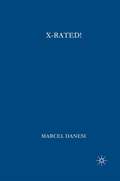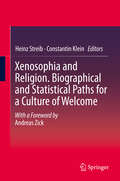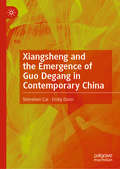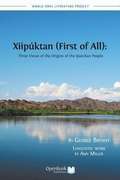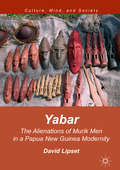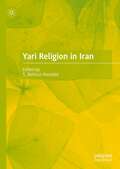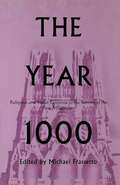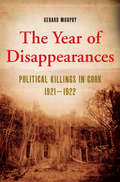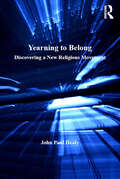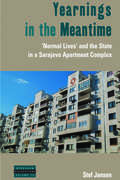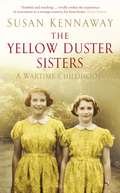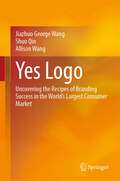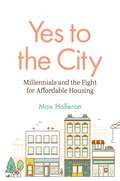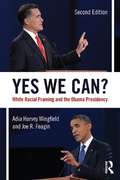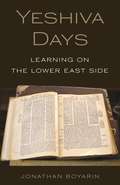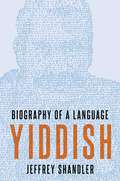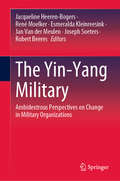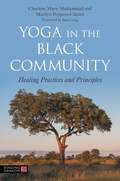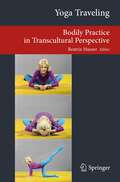- Table View
- List View
X-Rated!: The Power of Mythic Symbolism in Popular Culture
by Marcel DanesiMany attack pop culture as a crude 'sexual' and 'celebrity-based' culture that is purportedly bringing about the end of moral values. Renowned semiotician Marcel Danesi adds his signature insight to the debate by delving deep into pop culture through a consideration of symbols. Danesi's treatment of letters, such as the X in 'X-Rated,' the 'i' in 'iPod,' and other such symbols, reveals an ancient mythic structure that blends the sacred and profane dimensions of human psychic life. Danesi takes the reader on a remarkable exploration of the radical turns in American society, a society in which the search for pleasure and sexual expression often reign supreme. X-Rated! is a fascinating trip through what gives pop culture its secret appeal.
Xenosophia and Religion. Biographical and Statistical Paths for a Culture of Welcome: Biographical And Statistical Paths For A Culture Of Welcome
by Heinz Streib Constantin KleinThis book documents the current polarization in Germany regarding the issue of refugee immigration. It presents quantitative estimates for both xenophobia and xenophilia in the German population, including short-time changes. The book suggests a conceptual change of perspectives. It focuses not only on the pathogenic model that accounts for outcomes such as xenophobia, Islamophobia and other forms of (inter-religious) prejudice, but on a salutogenic model. In the book’s view, the salutogenic model entails xenosophia: the wisdom, creativity and inspiration that emerges from the encounter with the strange and the strange religion. The book addresses individual dispositions, which may lead to xenophobia or xenosophia, and takes into account predictors such as religiosity, religious schemata, value preferences, tolerance of complexity, and violence legitimizing norms of masculinity. A selection of case studies present typical biographical trajectories toward xenosophia.
Xiangsheng and the Emergence of Guo Degang in Contemporary China
by Shenshen Cai Emily DunnThis book explores xiangsheng, one of the most popular folk art performance genres in China, its enlistment by official propaganda machine after the founding of the People’s Republic of China (PRC) and its revival in popularity under Guo Degang and his Deyun Club. Just as the 1950's saw the shift of xiangsheng 's social function from entertainment to the political tool of ‘serving the party’, Guo Degang has completed the paradigm shift by turning its focus back to ‘serving the people’ as a means of entertainment and social criticism. This volume examines how Guo has resurrected the essence of xiangsheng, successfully commercialised it in a market economy, and simultaneously deconstructed the official discourse through grassroots means.
Xiipuktan (First of All): Three Views of the Origins of the Quechan People (PDF)
by George Bryant and Amy MillerThe Quechan people live along the lower part of the Colorado River in the United States. According to tradition, the Quechan and other Yuman people were created at the beginning of time, and their Creation myth explains how they came into existence, the origin of their environment, and the significance of their oldest traditions. The Creation myth forms the backdrop against which much of the tribe's extensive oral literature may be understood. At one time there were almost as many different versions of the Quechan creation story as there were Quechan families. Now few people remember them. This volume, presented in the Quechan language with facing-column translation, provides three views of the origins of the Quechan people. One synthesizes narrator George Bryant's childhood memories and later research. The second is based upon J. P. Harrington's A Yuma Account of Origins (1908). The third provides a modern view of the origins of the Quechan, beginning with the migration from Asia to the New World and ending with the settlement of the Yuman tribes at their present locations. Publication of this book is made possible by the Institute of Museum and Library Services Native American / Native Hawaiian Museum Services Program grant number MN-00-13-0025-13. This collection is for the Quechan people and will also interest linguists, anthropologists, oral literature specialists, and anyone curious about Native American culture.
Yabar: The Alienations of Murik Men in a Papua New Guinea Modernity
by David LipsetThis book analyses the dual alienations of a coastal group rural men, the Murik of Papua New Guinea. David Lipset argues that Murik men engage in a Bakhtinian dialogue: voicing their alienation from both their own, indigenous masculinity, as well as from the postcolonial modernity in which they find themselves adrift. Lipset analyses young men’s elusive expressions of desire in courtship narratives, marijuana discourse, and mobile phone use—in which generational tensions play out together with their disaffection from the state. He also borrows from Lacanian psychoanalysis in discussing how men’s dialogue of dual alienation appears in folk theater, in material substitutions—most notably, in the replacement of outrigger canoes by fiberglass boats—as well as in rising sea-levels, and the looming possibility of resettlement.
Yabar: The Alienations of Murik Men in a Papua New Guinea Modernity
by David LipsetThis book analyses the dual alienations of a coastal group rural men, the Murik of Papua New Guinea. David Lipset argues that Murik men engage in a Bakhtinian dialogue: voicing their alienation from both their own, indigenous masculinity, as well as from the postcolonial modernity in which they find themselves adrift. Lipset analyses young men’s elusive expressions of desire in courtship narratives, marijuana discourse, and mobile phone use—in which generational tensions play out together with their disaffection from the state. He also borrows from Lacanian psychoanalysis in discussing how men’s dialogue of dual alienation appears in folk theater, in material substitutions—most notably, in the replacement of outrigger canoes by fiberglass boats—as well as in rising sea-levels, and the looming possibility of resettlement.
Yari Religion in Iran
by S. Behnaz HosseiniThis book sheds light on the cultural traits and religious beliefs of the Yārsan community. By incorporating historical and ethnographic research on Yārsan community in west and North of Iran, fieldwork and meticulous analysis of religious texts and international literature, it reveals contemporary aspects of Yārsan culture and life that are lesser known to the wider public, and provides insights into their lives, traditions and prospects for the future. With researchers from inside Iran and all over the world, this book offers a new look at Yārsan.
The Year 1000: Religious and Social Response to the Turning of the First Millennium
This collection of new essays examines the long-standing question of apocalyptic expectations around the turn of the first millennium. Including works by scholars of medieval history, literature, and religion, this book argues that apocalyptic expectations did exist around the year 1000. It provides a more balanced and nuanced approach to the issue than the traditional views that either identify a time of fear, the 'terrors of the year 1000', or deny that awareness of the millennium existed. This book, instead, recognizes that there were a variety of responses to the eschatological years 1000 and 1033 and that these responses contributed to the broader social and religious developments associated with the birth of European civilization.
The Year of Disappearances: Political Killings in Cork 1921-1922
by Gerard Murphy‘Every spy who was shot in Cork was buried so that nothing was known about them. They just disappeared.’ These are the words of an IRA commander recalling the War of Independence in Cork city.The Year of Disappearances examines this claim and others like it.It uncovers a web of suspicion and paranoia that led to scores of men and boys being abducted from their homes before being executed as ‘enemies of the Republic’ and their bodies buried.While some of this took place during the War of Independence, most of it happened the following year, during the so-called ‘Cork Republic’. The net result was to change the demographic of the south-eastern corner of the city for ever, with hundreds of families fleeing and up to fifty individuals buried in unmarked graves in surrounding areas.Using a wide range of previously untapped sources, Murphy shines new light on one of the darker episodes of twentieth-century Irish history.
Yearning to Belong: Discovering a New Religious Movement (Routledge New Religions)
by John Paul HealyCutting across three areas of interest within New Religious Movements - insider perspectives, sociology of religion and the helping professions - this book explores insiders' experience of the Indian Guru-disciple Yogic tradition and is authored by a former member of that tradition. Highlighting the rich spiritual experience of devotees of Guru-disciple Yoga, and broadening the understanding of Guru-disciple Yoga Practice, this book also adds considerably to knowledge of conversion to New Religious Movements and to issues of affiliation and disengagement. Exploring participants' experience of attraction, affiliation and disengagement, these themes highlight individuals' personal experience of Guru-disciple Yoga Practice.
Yearning to Belong: Discovering a New Religious Movement (Routledge New Religions)
by John Paul HealyCutting across three areas of interest within New Religious Movements - insider perspectives, sociology of religion and the helping professions - this book explores insiders' experience of the Indian Guru-disciple Yogic tradition and is authored by a former member of that tradition. Highlighting the rich spiritual experience of devotees of Guru-disciple Yoga, and broadening the understanding of Guru-disciple Yoga Practice, this book also adds considerably to knowledge of conversion to New Religious Movements and to issues of affiliation and disengagement. Exploring participants' experience of attraction, affiliation and disengagement, these themes highlight individuals' personal experience of Guru-disciple Yoga Practice.
Yearnings in the Meantime: 'Normal Lives' and the State in a Sarajevo Apartment Complex (Dislocations #15)
by Stef JansenShortly after the book’s protagonists moved into their apartment complex in Sarajevo, they, like many others, were overcome by the 1992-1995 war and the disintegration of socialist Yugoslavia More than a decade later, in post-war Bosnia and Herzegovina, they felt they were collectively stuck in a time warp where nothing seemed to be as it should be. Starting from everyday concerns, this book paints a compassionate yet critical portrait of people’s sense that they were in limbo, trapped in a seemingly endless “Meantime.” Ethnographically investigating yearnings for “normal lives” in the European semi-periphery, it proposes fresh analytical tools to explore how the time and place in which we are caught shape our hopes and fears.
The Yellow Duster Sisters: A Wartime Childhood
by Susan Kennaway1939. Nine year old Susie and her sister Gyll live in Watford, and all week look forward to their Saturday shopping expedition to Woolworths with their nanny, to buy something nice for Mummy. But as war breaks out in Europe, the girls are evacuated to Africa. Feeling abandoned and alone, the sisters find their new life miserable and get no sympathy from their guardians, who force them to wear patched-up clothes and be in bed by six o'clock. As time passes and letters from home stop arriving, the sisters dream of escape and of returning to idyllic England. Yet when they finally do arrive home, all the changes that await them make for a very different life than the one they had longed for... Intensely funny and charming, Susan Kennaway writes about growing up during the Second World War with rare honesty and insight.
Yes Logo: Uncovering the Recipes of Branding Success in the World’s Largest Consumer Market
by Jiazhuo George Wang Shuo Qin Allison WangThis book focuses on how to succeed in China, the globe’s largest consumer market, through the branding market strategy. What are the undisclosed recipes that brands can follow to capture the attention and emotion of consumers in China? What’s the magical key to open the locked doors? The answer to these questions would be intriguing for many readers outside China, including but not limited to executives of global brands, owners of medium-and-small-sized businesses aiming for the global market, branding/marketing professionals, financial investors and analysts, business professors and researchers in universities and colleges, graduate and undergraduate students, and readers with an interest on these topics in the general public.In comparison with many case studies that focus on only a single or few cases, or else lean toward being a macro-discussions of China’s consumer market without in-depth analysis of representative cases, this book provides both. Many branding strategies, programs, and activities presented in this book are of the innovative type, which could be very fresh and interesting to readers. Many of the in-depth analyses and specific insights presented in this book are provided by well-recognized business analysts/writers, which may not be available in other publications. Overall, this book provides readers with the opportunity to receive some valuable new knowledge about how to succeed in the globe’s largest consumer market, providing foodstuff for both thought and enjoyment.
Yes to the City: Millennials and the Fight for Affordable Housing
by Max HolleranA fascinating account of the growing "Yes in My Backyard" urban movement The exorbitant costs of urban housing and the widening gap in income inequality are fueling a combative new movement in cities around the world. A growing number of influential activists aren&’t waiting for new public housing to be built. Instead, they&’re calling for more construction and denser cities in order to increase affordability. Yes to the City offers an in-depth look at the &“Yes in My Backyard&” (YIMBY) movement. From its origins in San Francisco to its current cadre of activists pushing for new apartment towers in places like Boulder, Austin, and London, Max Holleran explores how urban density, once maligned for its association with overpopulated slums, has become a rallying cry for millennial activists locked out of housing markets and unable to pay high rents.Holleran provides a detailed account of YIMBY activists campaigning for construction, new zoning rules, better public transit, and even candidates for local and state office. YIMBY groups draw together an unlikely coalition, from developers and real estate agents to environmentalists, and Holleran looks at the increasingly contentious battles between market-driven pragmatists and rent-control idealists. Arguing that advocates for more housing must carefully weigh their demands for supply with the continuing damage of gentrification, he shows that these individuals see high-density urbanism and walkable urban spaces as progressive statements about the kind of society they would like to create.Chronicling a major shift in housing activism during the past twenty years, Yes to the City considers how one movement has reframed conversations about urban growth.
Yes We Can?: White Racial Framing and the Obama Presidency
by Adia Harvey-Wingfield Joe FeaginThe first edition of this book offered one of the first social science analyses of Barack Obama’s historic electoral campaigns and early presidency. In this second edition the authors extend that analysis to Obama’s service in the presidency and to his second campaign to hold that presidency. Elaborating on the concept of the white racial frame, Harvey Wingfield and Feagin assess in detail the ways white racial framing was deployed by the principal characters in the electoral campaigns and during Obama’s presidency. With much relevant data, this book counters many commonsense assumptions about U.S. racial matters, politics, and institutions, particularly the notion that Obama’s presidency ushered in a major post-racial era. Readers will find this fully revised and updated book distinctively valuable because it relies on sound social science analysis to assess numerous events and aspects of this historic campaign.
Yes We Can?: White Racial Framing and the Obama Presidency
by Adia Harvey-Wingfield Joe FeaginThe first edition of this book offered one of the first social science analyses of Barack Obama’s historic electoral campaigns and early presidency. In this second edition the authors extend that analysis to Obama’s service in the presidency and to his second campaign to hold that presidency. Elaborating on the concept of the white racial frame, Harvey Wingfield and Feagin assess in detail the ways white racial framing was deployed by the principal characters in the electoral campaigns and during Obama’s presidency. With much relevant data, this book counters many commonsense assumptions about U.S. racial matters, politics, and institutions, particularly the notion that Obama’s presidency ushered in a major post-racial era. Readers will find this fully revised and updated book distinctively valuable because it relies on sound social science analysis to assess numerous events and aspects of this historic campaign.
Yeshiva Days: Learning on the Lower East Side
by Jonathan BoyarinAn intimate and moving portrait of daily life in New York's oldest institution of traditional rabbinic learningNew York City's Lower East Side has witnessed a severe decline in its Jewish population in recent decades, yet every morning in the big room of the city's oldest yeshiva, students still gather to study the Talmud beneath the great arched windows facing out onto East Broadway. Yeshiva Days is Jonathan Boyarin's uniquely personal account of the year he spent as both student and observer at Mesivtha Tifereth Jerusalem, and a poignant chronicle of a side of Jewish life that outsiders rarely see.Boyarin explores the yeshiva's relationship with the neighborhood, the city, and Jewish and American culture more broadly, and brings vividly to life its routines, rituals, and rhythms. He describes the compelling and often colorful personalities he encounters each day, and introduces readers to the Rosh Yeshiva, or Rebbi, the moral and intellectual head of the yeshiva. Boyarin reflects on the tantalizing meanings of "study for its own sake" in the intellectually vibrant world of traditional rabbinic learning, and records his fellow students' responses to his negotiation of the daily complexities of yeshiva life while he also conducts anthropological fieldwork.A richly mature work by a writer of uncommon insight, wit, and honesty, Yeshiva Days is the story of a place on the Lower East Side with its own distinctive heritage and character, a meditation on the enduring power of Jewish tradition and learning, and a record of a different way of engaging with time and otherness.
Yeshiva Days: Learning on the Lower East Side
by Jonathan BoyarinAn intimate and moving portrait of daily life in New York's oldest institution of traditional rabbinic learningNew York City's Lower East Side has witnessed a severe decline in its Jewish population in recent decades, yet every morning in the big room of the city's oldest yeshiva, students still gather to study the Talmud beneath the great arched windows facing out onto East Broadway. Yeshiva Days is Jonathan Boyarin's uniquely personal account of the year he spent as both student and observer at Mesivtha Tifereth Jerusalem, and a poignant chronicle of a side of Jewish life that outsiders rarely see.Boyarin explores the yeshiva's relationship with the neighborhood, the city, and Jewish and American culture more broadly, and brings vividly to life its routines, rituals, and rhythms. He describes the compelling and often colorful personalities he encounters each day, and introduces readers to the Rosh Yeshiva, or Rebbi, the moral and intellectual head of the yeshiva. Boyarin reflects on the tantalizing meanings of "study for its own sake" in the intellectually vibrant world of traditional rabbinic learning, and records his fellow students' responses to his negotiation of the daily complexities of yeshiva life while he also conducts anthropological fieldwork.A richly mature work by a writer of uncommon insight, wit, and honesty, Yeshiva Days is the story of a place on the Lower East Side with its own distinctive heritage and character, a meditation on the enduring power of Jewish tradition and learning, and a record of a different way of engaging with time and otherness.
Yiddish: Biography of a Language
by Jeffrey ShandlerThe most widely spoken Jewish language on the eve of the Holocaust, Yiddish continues to play a significant role in Jewish life today, from Hasidim for whom it is a language of daily life to avant-garde performers, political activists, and LGBTQ writers turning to Yiddish for inspiration. Yiddish: Biography of a Language presents the story of this centuries-old language, the defining vernacular of Ashkenazi Jews, from its origins to the present. Jeffrey Shandler tells the multifaceted history of Yiddish in the form of a biographical profile, revealing surprising insights through a series of thematic chapters. He addresses key aspects of Yiddish as the language of a diasporic population, whose speakers have always used more than one language. As the vernacular of a marginalized minority, Yiddish has often been held in low regard compared to other languages, and its legitimacy as a language has been questioned. But some devoted Yiddish speakers have championed the language as embodying the essence of Jewish culture and a defining feature of a Jewish national identity. Despite predictions of the demise of Yiddish-dating back well before half of its speakers were murdered during the Holocaust-the language leads a vibrant, evolving life to this day.
Yiddish: Biography of a Language
by Jeffrey ShandlerThe most widely spoken Jewish language on the eve of the Holocaust, Yiddish continues to play a significant role in Jewish life today, from Hasidim for whom it is a language of daily life to avant-garde performers, political activists, and LGBTQ writers turning to Yiddish for inspiration. Yiddish: Biography of a Language presents the story of this centuries-old language, the defining vernacular of Ashkenazi Jews, from its origins to the present. Jeffrey Shandler tells the multifaceted history of Yiddish in the form of a biographical profile, revealing surprising insights through a series of thematic chapters. He addresses key aspects of Yiddish as the language of a diasporic population, whose speakers have always used more than one language. As the vernacular of a marginalized minority, Yiddish has often been held in low regard compared to other languages, and its legitimacy as a language has been questioned. But some devoted Yiddish speakers have championed the language as embodying the essence of Jewish culture and a defining feature of a Jewish national identity. Despite predictions of the demise of Yiddish-dating back well before half of its speakers were murdered during the Holocaust-the language leads a vibrant, evolving life to this day.
The Yin-Yang Military: Ambidextrous Perspectives on Change in Military Organizations
by Jacqueline Heeren-Bogers René Moelker Esmeralda Kleinreesink Jan Van der Meulen Joseph Soeters Robert BeeresThis book examines change processes and the challenge of ambidexterity in military organizations. It discusses how military organizations can better adapt to the complex, and at times chaotic, environments they operate in by developing organizational ambidexterity. The authors identify various multiple tasks and functions of military organizations that require multi-dimensional and often contradictory operational, technological, cultural, and social skills. In analogy to the often-opposed functions performed by the right and left hand of the body, modern military organizations are no longer one-dimensional fighting machines, but characterized by a duality of tasks, such as fighting and peacekeeping which often make part and parcel of one and the same mission. The military is both a “hot” and a “cold” organization (a crisis management organization and a bureaucracy). As such, the book argues that these dualities are not necessarily opposed but can serve as complementary forces, like the yin and yang, to better the overall performance of these organizations. As a consequence, ambidextrous organizations excel at complex tasking and are adaptable to new challenges. Divided into four parts: 1) structures and networks; 2) cultural issues; 3) tasks and roles; 4) nations and allies, it appeals to scholars of military studies and organization studies as well as professionals working for governmental or military organizations.
Yoga in the Black Community: Healing Practices and Principles
by Charlene Marie Muhammad Marilyn Peppers-CitizenAs the practice of yoga continues to flourish within Western Black and Brown communities, this transformative, Black culturally centered toolkit highlights the barriers that hinder access to yoga. It takes core aspects of yoga philosophy and contextualizes it within Black cultural norms, religious taboos, and historical healing practices, and teaches readers how to foster a safe haven for their clients and communities.Based on decades' worth of experience and expertise, this dynamic author duo discusses important topics such as health disparities, complementary healthcare, and the rich heritage and resilience of Black communities. This is an invaluable and practical resource that offers practices and actionable guidance and supports practitioners to explore a Black culturally centered approach to yoga whilst facilitating better health and wellbeing for Black people.
Yoga in the Black Community: Healing Practices and Principles
by Charlene Marie Muhammad Marilyn Peppers-CitizenAs the practice of yoga continues to flourish within Western Black and Brown communities, this transformative, Black culturally centered toolkit highlights the barriers that hinder access to yoga. It takes core aspects of yoga philosophy and contextualizes it within Black cultural norms, religious taboos, and historical healing practices, and teaches readers how to foster a safe haven for their clients and communities.Based on decades' worth of experience and expertise, this dynamic author duo discusses important topics such as health disparities, complementary healthcare, and the rich heritage and resilience of Black communities. This is an invaluable and practical resource that offers practices and actionable guidance and supports practitioners to explore a Black culturally centered approach to yoga whilst facilitating better health and wellbeing for Black people.
Yoga Traveling: Bodily Practice in Transcultural Perspective (Transcultural Research – Heidelberg Studies on Asia and Europe in a Global Context)
by Beatrix HauserThis book focuses on yoga’s transcultural dissemination in the twentieth and twenty-first centuries. In the course of this process, the term “yoga” has been associated with various distinctive blends of mental and physical exercises performed in order to achieve some sort of improvement, whether understood in terms of esotericism, fitness, self-actualization, body aesthetics, or health care. The essays in this volume explore some of the turning points in yoga’s historico-spatial evolution and their relevance to its current appeal. The authors focus on central motivations, sites, and agents in the spread of posture-based yoga as well as on its successive (re-)interpretation and diversification, addressing questions such as: Why has yoga taken its various forms? How do time and place influence its meanings, social roles, and associated experiences? How does the transfer into new settings affect the ways in which yogic practice has been conceptualized as a system, and on what basis is it still identified as (Indian) yoga? The initial section of the volume concentrates on the re-evaluation of yoga in Indian and Western settings in the first half of the twentieth century. The following chapters link global discourses to particular local settings and explore meaning production at the micro-social level, taking Germany as the focal site. The final part of the book focuses on yoga advertising and consumption across national, social, and discursive boundaries, taking a closer look at transnational and deterritorialized yoga markets, as well as at various classes of mobile yoga practitioners.
